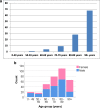Odontoid fractures: impact of age and comorbidities on surgical decision making
- PMID: 33054819
- PMCID: PMC7556921
- DOI: 10.1186/s12893-020-00893-7
Odontoid fractures: impact of age and comorbidities on surgical decision making
Abstract
Background: Surgical fixation is recommended for type II and III odontoid fractures (OFx) with major translation of the odontoid fragment, regardless of the patient's age, and for all type II OFx in patients aged ≥50 years. The level of compliance with this recommendation is unknown, and our hypothesis is that open surgical fixation is less frequently performed than recommended. We suspect that this discrepancy might be due to the older age and comorbidities among patients with OFx.
Methods: We present a prospective observational cohort study of all patients in the southeastern Norwegian population (3.0 million) diagnosed with a traumatic OFx in the period from 2015 to 2018.
Results: Three hundred thirty-six patients with an OFx were diagnosed, resulting in an overall incidence of 2.8/100000 persons/year. The median age of the patients was 80 years, and 45% were females. According to the Anderson and D'Alonzo classification, the OFx were type II in 199 patients (59%) and type III in 137 patients (41%). The primary fracture treatment was rigid collar alone in 79% of patients and open surgical fixation in 21%. In the multivariate analysis, the following parameters were significantly associated with surgery as the primary treatment: independent living, less serious comorbidities prior to the injury, type II OFx and major sagittal translation of the odontoid fragment. Conversion from external immobilization alone to subsequent open surgical fixation was performed in 10% of patients. Significant differences the in conversion rate were not observed between patients with type II and III fractures. The level of compliance with the treatment recommendations for OFx was low. The main deviation was the underuse of primary surgical fixation for type II OFx. The most common reasons listed for choosing primary external immobilization instead of primary surgical fixation were an older age and comorbidities.
Conclusion: Major comorbidities and an older age appear to be significant factors contributing to physicians' decision to refrain from the surgical fixation of OFx. Hence, comorbidities and age should be considered for inclusion in the decision tree for the choice of treatment for OFx in future guidelines.
Keywords: Age factors; Comorbidity; Guideline adherence; Odontoid process/injury; Risk factors; Spinal fractures/epidemiology; Spinal fractures/surgery.
Conflict of interest statement
The authors declare that they have no competing interests.
Figures
References
MeSH terms
LinkOut - more resources
Full Text Sources
Medical


